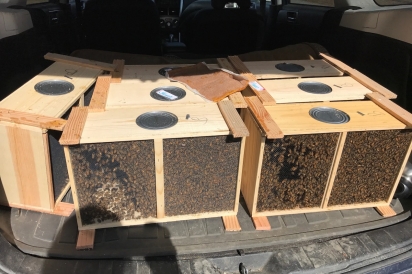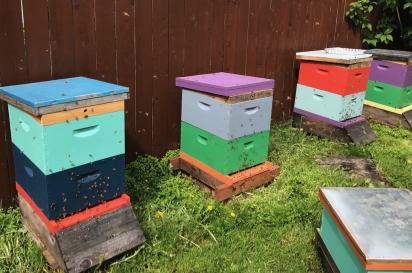How Sweet it is; The Buzz about Alaska's Honey Bees
When I moved back to Alaska ten years ago, my mom invited me to her house in south Mountain View to check out her new hobby: beekeeping. She’d been taking classes all winter and was excited to do her first hive check on her own. From my “safe” viewing area, about 6 feet back, I was unsure what the appeal was. She hadn’t invested in a proper bee suit yet, and her get-up did little in the way of preventing angry spring bees from doing their best to keep her out of their home. She, meanwhile, having been stung about a dozen times, was brimming about the “foundation pattern” and “finding” her queen. Over the summer, I eventually got more comfortable around the bees, learned the basics of hive management, and slowly began to love and appreciate the 100,000 or so ladies flying around her backyard.
That winter I took an introductory bee class through Southeast Alaska Beekeepers Association (SABA), which offers a number of courses throughout the state and year. I also bought a proper bee suit. Many beekeepers in Alaska (and elsewhere) don’t use suits, but I find that extra bit of protection makes for a more enjoyable experience. Beekeepers invariably get stung, and while most of them become less reactive over time, an unlucky few swing the opposite direction and become allergic. While a bee suit doesn’t prevent 100% of stings, it does limit the exposure.
Armed with my suit and new knowledge, I ended up getting my own hives — and taking over my mom’s. Now, with eight hives in various yards throughout Anchorage, I can’t imagine a life without bees. Most mornings, I start with a cup of coffee outside watching them come and go; covered with various colored pollen from the neighboring Chester Creek Greenbelt, nearby apple and fruit trees, and neighborhood gardens.
Beekeeping is more than morning coffee, however. It’s a pretty intensive agricultural practice with feedings required in the spring and fall that involve making hundreds of pounds of sugar water. Those people you see at Costco with the carts of sugar in the spring? Hands down they’re beekeepers supplementing food (generally a 2:1 sugar/water ratio) before the nectar starts to run — and then trying to get their hives full after their last honey harvest in the fall.
Those sugar feedings take time, and sugar jars or internal feeders need to be changed every day or two. During the summer, hives need to be checked every 10-14 days to prevent swarming and ensure proper hive health and productivity. If you think it’s hard to find a dog sitter, imagine finding someone who’s willing to open your hives while you’re off camping for the weekend. Over the years, I’ve had a total of one friend agree to watch over my ladies. It’s the ultimate hard sell.
Urban beekeeping has challenges of its own. While most neighbors are understanding of bees, the hives can impose some problems on those living closest to you. Tall fences and honey deliveries help, but sometimes even the most understanding neighbors need some convincing. In my early years of beekeeping, before I understood hive management, I had a full hive swarm (about 120,000 bees) mere minutes before my neighbor’s 2-year-old son’s outdoor birthday party. And when bees swarm, they evacuate their waste. Thick, sticky brown raindrops fall from the sky and cover everything below the cloud of bees: trees, grass, cars, children, games, etc. Next they group up somewhere close by, like the tallest tree above the kiddie pool next door. You have to have some pretty exceptional neighbors to laugh that one off. If you’re considering bees, make sure you’re in good standing with your neighbors. You’re going to need them to remember they like you.
Honey harvesting occurs in July and August and can be easier as a two-person operation. Beekeeping, while a chosen operation for myself, is thrust upon my husband, Ian. When we first met, I think he thought it was a weird activity that he would sometimes enjoy watching from inside behind glass windows and mesh bug screens. As my hives have expanded, he’s been pulled, mostly willingly, into the process.
Around July when we do our first extraction, I’ll bring the full frames inside for him to de-cap (remove the top layer of protective wax that covers the honey frames) by hand. Although it’s not the most efficient way to get your honey, all of our honey is tediously spun out in our hand-cranked extractor so that we never introduce heat to the product, which can kill some of the beneficial bacteria found in raw honey. If I’m doing my part correctly, very few bees end up inside the house. If I’m distracted or trying to beat approaching weather, both my husband and the dogs hiding inside let me know.
Each area of Alaska has its own rules about how many and where you can keep beehives, though they all need to be registered with the Department of Agriculture. In Anchorage, each person can have up to four hives in their yard. In Airport Heights — where I live and keep many of my hives — beekeeping has provided an excellent opportunity to talk with my neighbors about pesticide use and being a responsible urban resident. Bees drink water (note: bees drink A LOT of water) off of leaves and grass and collect nectar and pollen from nearby plants.Pesticides and herbicides are ingested by bees and can be responsible for the diminished health of the colony, and they can end up in your honey. Dandelions, a critical spring and summer food, are especially contentious. A great way to keep them down without pesticides is to keep your lawn short and pull the heads off of the plant before they have a chance to seed. That clover in your yard is also a bee’s favorite (and a sign of a healthy lawn). So next time you’re concerned about not having a picture-perfect lawn, think about how happy the pollinators in your area are — not to mention the aquatic creatures who encounter that yard runoff in our streams and rivers. If you’re thinking about beekeeping, there are some excellent resources throughout the state. I would start by joining your local bee group.
There are generous and knowledgeable beekeepers here who are happy to mentor newbees, but be aware that it’s not an inexpensive hobby. There’s a reason local honey is so expensive. To get started you’ll need a basic hive ($300), a smoker ($45), hive tools ($10), and a bee suit ($95). The bees themselves are an additional $200 a hive for a single queen and about 20,000 bees. If you join a bee club they often have extractors you can borrow, or you can purchase one for around $400. Bee equipment is expensive to ship up from the lower 48, but it is getting easier to find locally. I prefer a family run operation based out of Big Lake called Alaska Wildflower Honey that has everything you could need, plus great advice. Alaska Mill and Feed also sells some basics for getting started.
There are a number of different hive designs that work well for different areas; I’ve found the best to be the standard ten frame box. I’ve tried the Flow Hive, which was introduced to the market in recent years, but having been designed in Australian climates, it doesn’t “flow” so well in Alaska’s cooler temps. With its side windows, however, it’s a fun way to watch your bees work if you’re less interested in collecting honey at the end of the season.
If you’re not interested in beekeeping (and it’s not for everyone) there are things you can do to support our local pollinators: stop or minimize your use of pesticides, plant native pollinating plants (be careful not to bring in invasive plants), and support your local beekeeper. Beekeeping is a labor of love; it’s expensive and unpredictable with our changing summer weather. Southcentral Alaska honey is often mild and sweeter than most. Once you start to appreciate the differences in honey you’ll be buying jars everywhere you travel. It’s one of the few things that is truly regional: honey has a different flavor in Anchorage than it would in Homer, Fairbanks, or the lower 48, and it even varies from year to year. Raw, regionalized, local honey has also been found to help allergies, asthma, and is one of the most enjoyable ways to soothe a sore throat or cough. Raw honey should never be refrigerated or microwaved, and though it’s likely to harden up in a cold house, it will never expire. If you do have hardened honey, place it in warm water until it re-liquefies in order to maintain the health benefits and the honey’s integrity.
This year I’ll be nine months pregnant come the first harvest. Ian will be outside with me lifting the heavy boxes of frames, foundation (comb), and honey, often weighing 60 or more pounds when full. Hope - fully, he’ll find his inner bee whisperer. Otherwise, it’s going to be a long summer. Don’t worry — I ordered him a bee suit.








